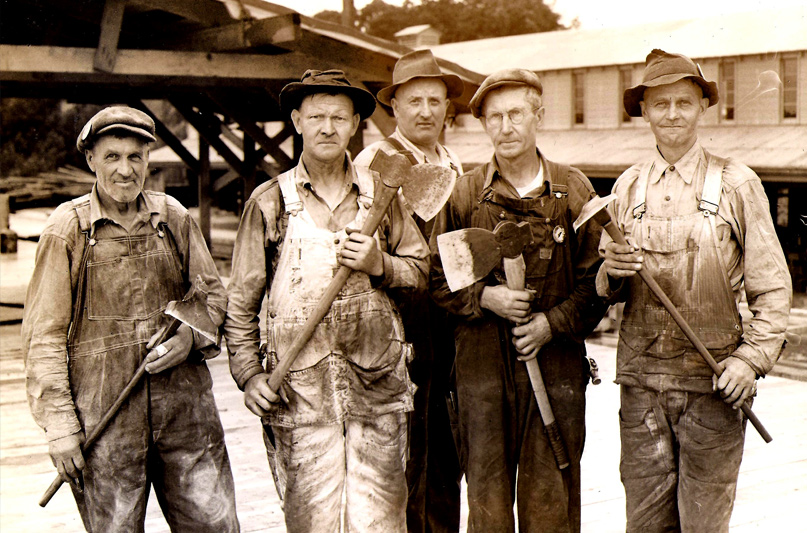
Seventy-five years ago, after the D-Day landings in France and as the USA began to push the Japanese forces out of the western Pacific islands, every boatyard on the West Coast was enlisted to aid the war effort by producing some type of craft that could be used by the military. This included many wooden boats that ranged from the Higgins 36’ plywood landing craft to the 136’ YMS double-planked minesweeper. However, there is one type of wooden vessel you will never find in the official list of WWII ships—the 110’ wooden barges built for US Army and Navy on the Willamette River in Southwest Portland, Oregon. They were a product of the Portland Shipbuilding Company, a business that claimed the title of the oldest boat-building operation in Oregon into the 1960s, when it disappeared leaving only the faintest wake.
The Portland Shipbuilding Company was founded in 1885 by Charles M. Nelson—a Norwegian immigrant who became one of the pioneers in the construction of the wooden sternwheel riverboats. These fine steam-powered craft provided the only form of reliable transportation between the Willamette Valley farming towns and Portland from the late 1800s to the 1930s, traveling as far upstream as the state capitol in Salem, 50 miles south when the river was high. Nelson built 25 of them before the highways captured all the freight traffic.
Nelson’s son Albert took over the yard in the 1930s when steel construction was becoming more accepted by the inland boatmen. To convert the yard to steel construction during the Depression was not feasible, and the yard built its reputation on its expertise with big wooden hulls. Fortunately, there was still some demand for the wooden barges because their solid bottom could withstand heavy impacts and groundings better than steel.
They began producing sturdy cargo carriers in a standard 110’ size with a combination of traditional craftsmanship and production-line methods on their side-haul marine railway. Much of the work was still done by hand, but the heavy baulks of timber were hoisted with the aid of a 10-ton steam-crane equipped with a 55-foot boom, running along the shore on a narrow-gauge track. There were also a handful of wooden sternwheel steam tugs moving ships around in the Port of Portland that needed regular maintenance and repair, which helped keep the yard afloat until Pearl Harbor.
Early in World War II, barges were desperately needed to haul military supplies along the West Coast and to the forward bases in Alaska and Hawaii. With steel in short supply and all the wooden shipyards busy with minesweepers and small craft, the Army and Navy looked for alternatives. There must have been some eyebrows raised when it was suggested they consider wooden barges, but they sent representatives to Portland Shipbuilding to examine one of the yard’s standard designs.
They were surprised and impressed by the construction method perfected on the Columbia and Willamette rivers using the plentiful supplies of lumber. It involved stacking large Douglas fir beams to form the sides, drilling through the assembly, and inserting long vertical bolts to create an incredibly solid hull. Portland Shipbuilding was given a military contract and went straight to work joining the numerous marine industries on the Willamette in the war effort.
“We had 68 men on the job and built 68 barges,” Nelson told the Oregonian’s marine editor Larry Barber in 1969 for a story in the newspaper’s weekend magazine on the yard’s closure. Good craftsmen were scarce, he recalled, so he promoted half a dozen experienced shipwrights and carpenters to serve as leadmen, directing the work of the scores of inexperienced men who joined the crew after being rejected by the draft. Like the other local four small independent shipyards and the three Kaiser operations, they started work cautiously, but soon began to speed up production until they could launch a barge every week.

Less than 30 experienced caulkers were available in Portland for all the wooden boats being constructed, but Nelson managed to keep eight to ten of them busy, he explained, although the Navy insisted they use heavy powered caulking machines on the deck to speed up the work. To protect the bottom from rot caused by rain and spray, five tons of rock salt was spread out in each barge to pickle the wood. In 16 months, the yard turned out well over “a mile of barges” for the Army, Navy, and maritime commissions, said Nelson proudly. That meant about one per week!
The company continued to maintain and repair the remaining wooden barges on the Willamette and lower Columbia Rivers until 1964, when a big flood destroyed the shipway. In 1969, Nelson sold the property to the city to convert into a new waterfront park. At that time, some of the company’s pre-war barges built with high-quality lumber were still working locally, Barber noted in his article.
The Willamette Sailing Club was founded nearby in 1961 and moved to a site close to Portland Shipbuilding in 1967. Amazingly, some wooden barges can still be found in local creeks and mudflats around the Northwest, easily identified by the rows of long bolts reaching up to snare any boater who strays too close.